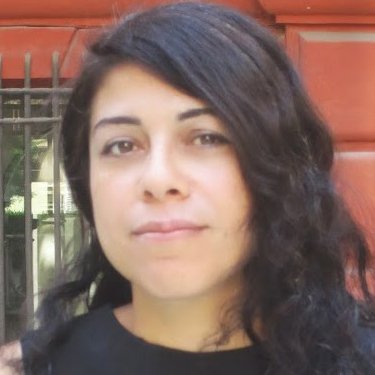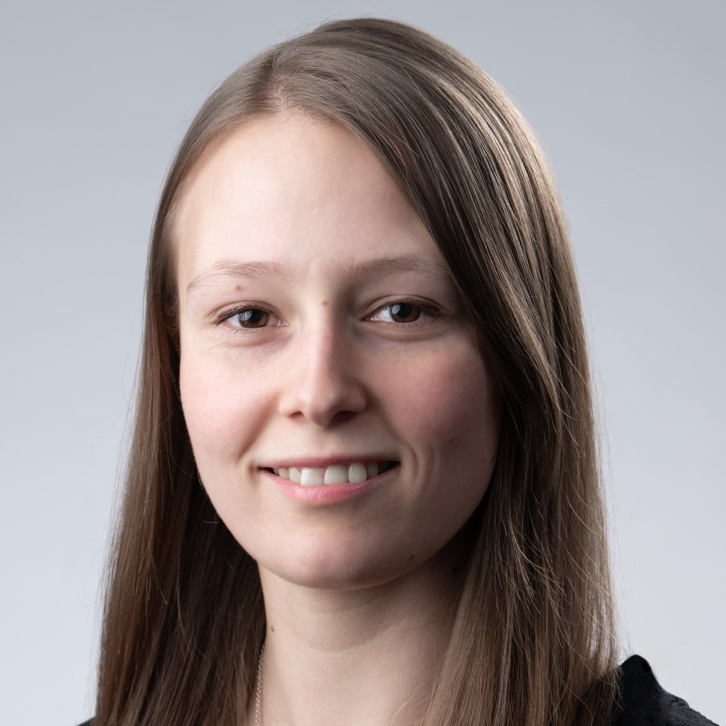STE Highlights, November 2020
Awards and Recognition
Chemistry
Americium isotope advances for quality control standards and commercial use
Progress in fission product diagnostics for post-detonation nuclear forensics
Infrastructure Enhancement
BSL-2 Lab in Chemical Microscopy Facility expands
High-explosives R&D Crystal Lab relocation and renovation complete
Materials Physics and Applications
First connection between a specific phase transition and superconductivity
Materials Science and Technology
Modeling predicts the role of grain boundary structure in materials in extreme environments
Integrated approach accelerates nuclear fuel development and qualification
Awards and Recognition
Morreale named vice chair of APS Four Corners Section
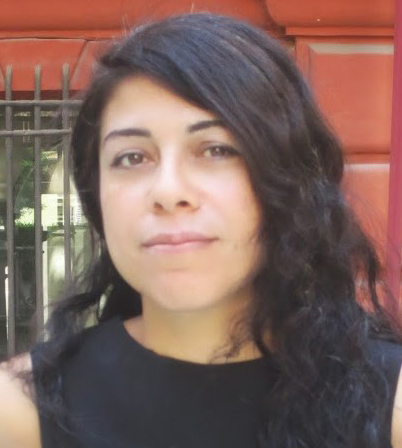
Astrid Morreale
Astrid Morreale (Subatomic Physics, P-25) has been elected vice chair of the American Physical Society’s Four Corners Section. As a member of its executive committee, she will help advance the section’s mission to provide opportunities supporting the professional development of scientists and students in the Four Corners region of New Mexico, Arizona, Colorado, and Utah.
“As physicists we have an advantageous position to be able to reach out to both the general and specialized public thanks to the multidisciplinary predisposition of our field,” Morreale said. “It is of crucial importance, especially now, that we invest within our communities to ensure that science in general has a strong presence in every household.”
Her four-year term as vice chair, chair-elect, chair, and past chair began in November.
Morreale is a member of P-25’s High Energy Nuclear Physics team. Her research expertise encompasses hadronic/nuclear structure in a variety of collision systems and center of mass energies.
After earning her Ph.D. in 2009 in nuclear and particle physics from the University of California, Riverside, Morreale accepted a private investigator grant from the National Science Foundation to work at the Atomic Energy Commission in France. She remained in Europe for the next 10 years and received her “Habilitation Thesis in Physics,” the highest title that can be conferred upon a scholar in France. Prior to joining the Lab in 2019, she was an associate professor at the Engineering School IMT of Nantes (France) and performed her research at the Large Hadron Collider. She is a peer reviewer for several national and international journals and a fellowship evaluator for the European Research Council, Horizon H2020 initiative. Morreale is a United States Marines Corps veteran.
Technical contact: Astrid Morreale
Graduate student Danielle Schaper first-ever LANL recipient of APS4CS Lustig Award
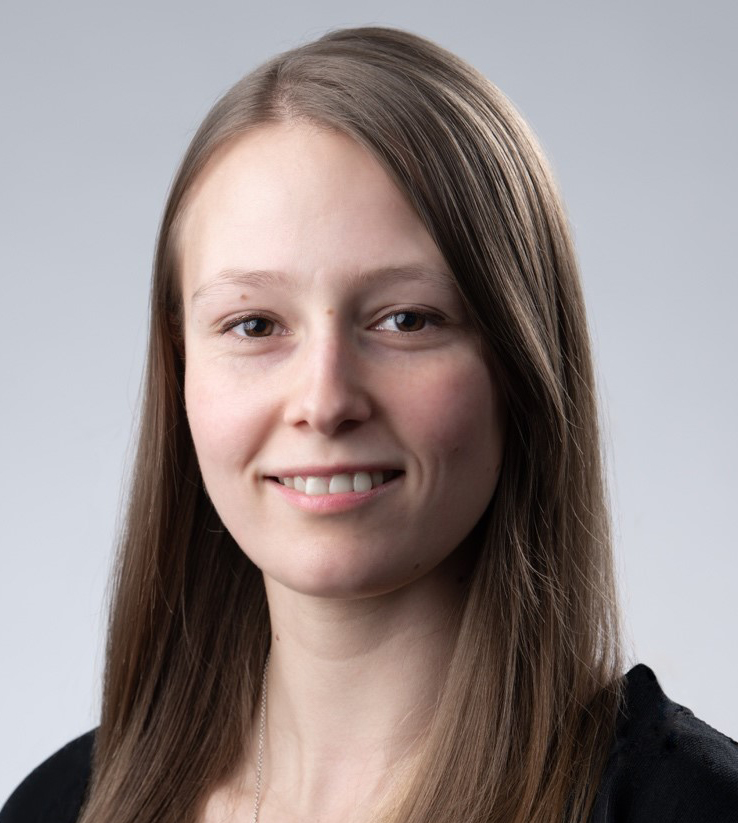
Danielle Schaper
Danielle Schaper of Materials Science in Radiation and Dynamics Extremes (MST-8) won the Harry Lustig Award from the American Physical Society Four Corners Section (APS4CS). The award recognizes outstanding graduate-level research performed in the Four Corners states.
Schaper presented her work on “Searching for evidence of time-reversal violation in neutron-nucleus resonance interactions” at the annual APS4CS meeting. She is the first LANL representative to win the award.
Members of the award committee commented specifically on the quality of Schaper’s presentation, which focused on the parity violation work of the NOPTREX collaboration being done at the Los Alamos Neutron Science Center (LANSCE), and her ability to project her enthusiasm and passion for the subject matter despite the challenges of the presentation’s virtual format. To learn more about this work, see the STE highlight here.
“Science communication is one of my personal passions, so having the opportunity to give a talk where the challenge was to communicate a very specialized research topic to a broad audience was honestly enough of a reward in and of itself. Being announced as the award recipient was absolutely an unexpected cherry on top,” Schaper said. “Being recognized for a skill that I have spent a lot of time and energy refining has been very validating.”
As a member of the MST-8 Scattering team and mentored by Sven Vogel (MST-8), Schaper is also applying her skills to help characterize advanced scintillator materials for fast neutron radiography at LANSCE’s Weapons Neutron Research Facility. She works on developing nuclear physics methods, such as neutron resonance spectroscopy, into tools for materials characterization and applying them to materials like irradiated nuclear fuels at LANSCE’s Lujan Center.
Schaper is completing her Ph.D. in experimental nuclear physics at the University of Kentucky. Prior to her student appointment at LANL, she received a joint National Science Foundation/Japan Society for Promotion of Science fellowship, which allowed her to conduct related experiments at Japan’s J-PARC facility. She is also a National Science Foundation Graduate Research Fellow.
The Lustig award, established in 2015, honors the APS secretary‐treasurer who was instrumental in the formation of the APS4CS.
“I dedicate this success to my biggest supporters, my cats: Sparkplug, Baer, Tachyon, and Flux,” Schaper said, laughing. “I work hard so they can live the lives they deserve.”
Technical contact: Danielle Schaper
Chemistry
Americium isotope advances for quality control standards and commercial use
Los Alamos scientists in the Actinide Analytical Chemistry (C-AAC) group made important strides toward the quality control of a radioactive actinide commonly used in household smoke detectors: americium (Am).
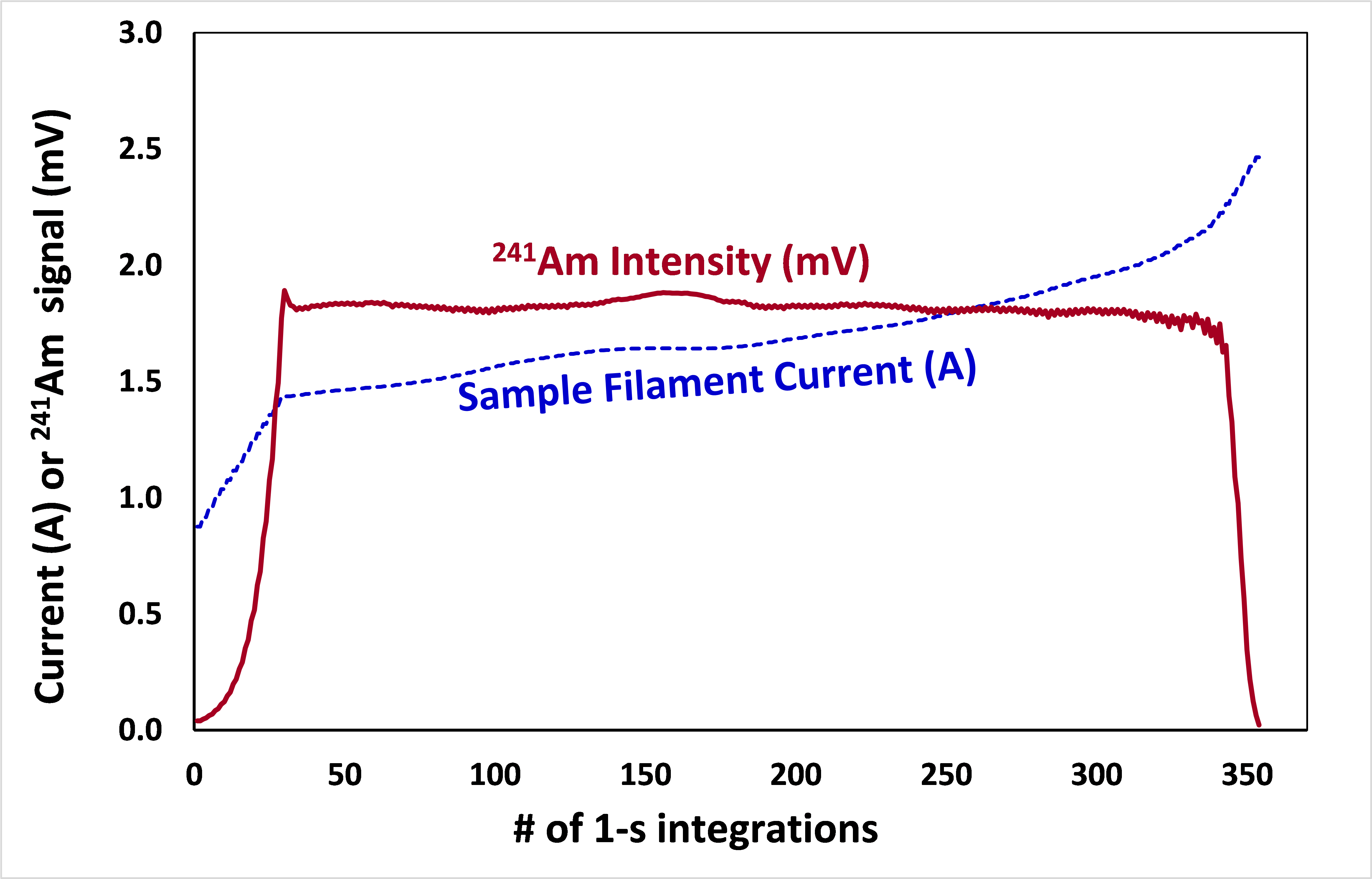
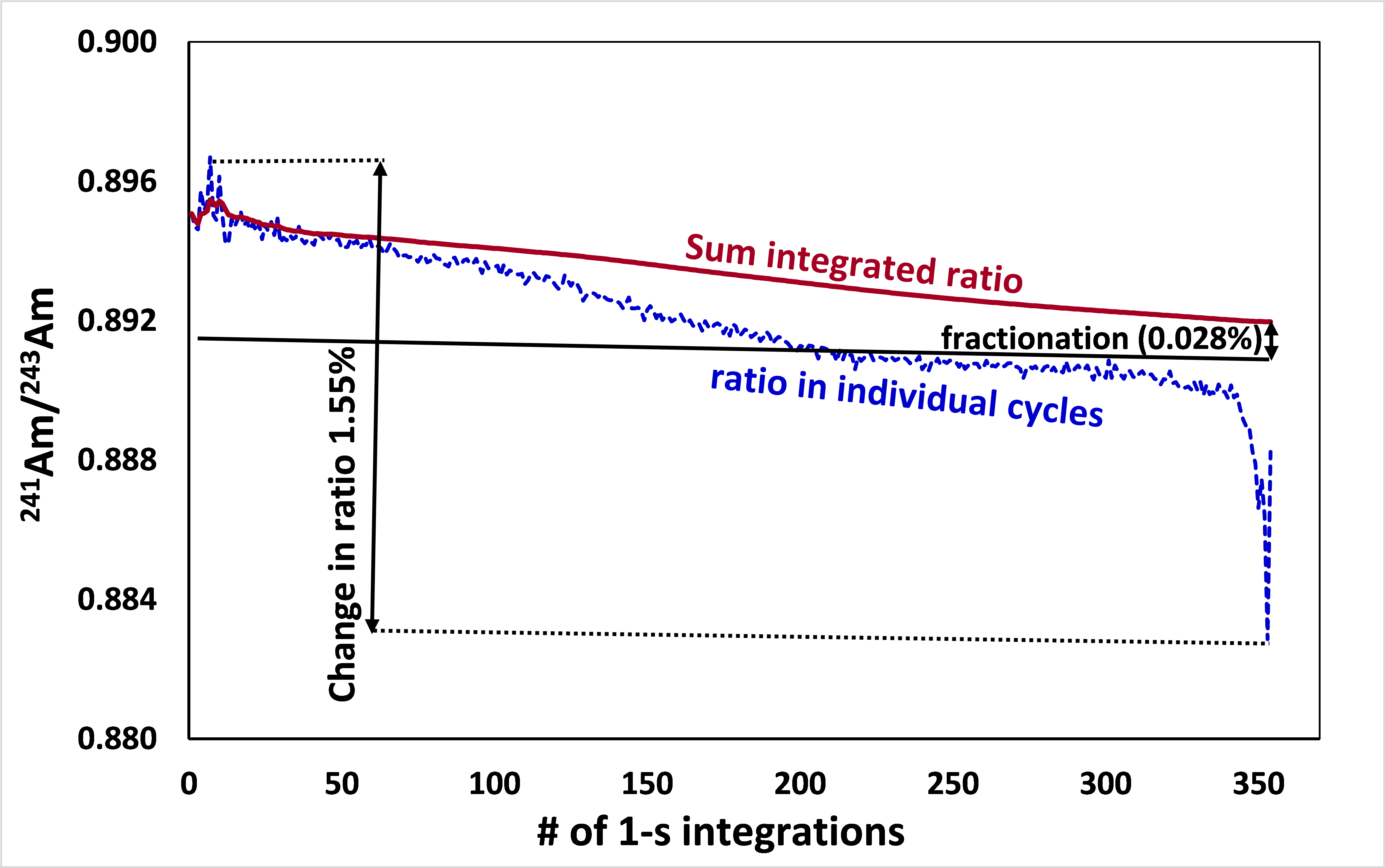
Evaporation filament current (A) and Am-241 signal intensities (mV) (top) and sum integrated Am-241/Am-243 as well as Am isotope ratios in individual cycles during the total evaporation analyses (bottom). Although measured isotope ratios change by 1.55% during the course of analysis, the sum-integrated ratio is different from the true (characterized) ratio only by 0.028%.
Specifically, 241AmO2 is used by industrial manufacturers of well-logging sources and domestic smoke detectors, and certification of this material is crucial for quality control and safety. However, certified isotopic standards for Am are not commercially available. Based on this need, the Los Alamos researchers employed a highly accurate and state-of-the-art isotopic measurement technique for the characterization of americium oxide.
LANL’s actinide expertise
Los Alamos specializes in actinides, such as plutonium, and maintains inventory of such materials. Over time, this inventory undergoes decay, producing americium as a byproduct (beta-decay of 241Pu produces 241Am). This americium can be recovered and sold commercially as americium oxide.
The Department of Energy Office of Science funded this Am recovery effort at Los Alamos, where expert actinide recovery and processing is routine. The production effort has the benefit of reducing external radiation exposures while providing a domestic source of 241AmO2.
A vetted technique for certification
In order to certify 241AmO2 product material, the scientists developed analytical methods to characterize attributes in the 241AmO2 production specification. Specifically, analytical methods support the need for Am isotopic and assay measurements.
Their published research describes the preparation and characterization of three isotope ratio mixtures with distinct 241Am/243Am, starting with commercially available 241Am and 243Am gamma-standards. Prepared mixtures were analyzed using the state-of-the-art total evaporation methodology that has been demonstrated to yield 240Pu/239Pu and 235U/238U isotope ratios with expanded uncertainties of ~0.03%. The 241Am/243Am ratios in the prepared mixtures were characterized to better than 0.1% and with sufficient reproducibility to be used as quality control standards for isotope ratio measurements of americium oxide samples.
The researchers also prepared a 243Am spike standard for Am assay measurements using thermal ionization mass spectrometry instruments by the isotope dilution mass spectrometry (IDMS) method. This assay method is based on the mass spectrometric analysis of a mixture of the sample with a spike of distinctly different isotopic composition than the sample. The mixtures were analyzed over a time period greater than one year so that the long-term stability of the prepared isotopic mixtures could be demonstrated. The IDMS technique yielded 241Am assay values with expanded uncertainties of ~0.1% (95% confidence levels using a coverage factor k = 2).
Funding and mission
This research was funded by the Department of Energy Office of Science. The work supports the Laboratory’s Nuclear Deterrence mission area and the Nuclear and Particle Futures capability pillar.
Reference: Mathew K.J., Ottenfeld C.F., Keller R.C., Kuhn K.J., and Fulwyler J.B. “Preparation of 241Am/243Am gravimetric mixtures and development of Am isotopic and assay measurement techniques using thermal ionization mass spectrometry.” International Journal of Mass Spectrometry. (2020) https://doi.org/10.1016/j.ijms.2020.116430
Technical contact: Kattathu Mathew
Progress in fission product diagnostics for post-detonation nuclear forensics
Fission product distributions are sensitive to both fuel type and neutron energy and provide useful diagnostics for post-detonation nuclear forensics. A recent set of inter-laboratory experiments with LANL and Pacific Northwest National Laboratory (PNNL) involved measurements of fission product ratios and yields in irradiations of high-enriched uranium (HEU) and depleted uranium (DU) in a 14 MeV neutron spectrum.
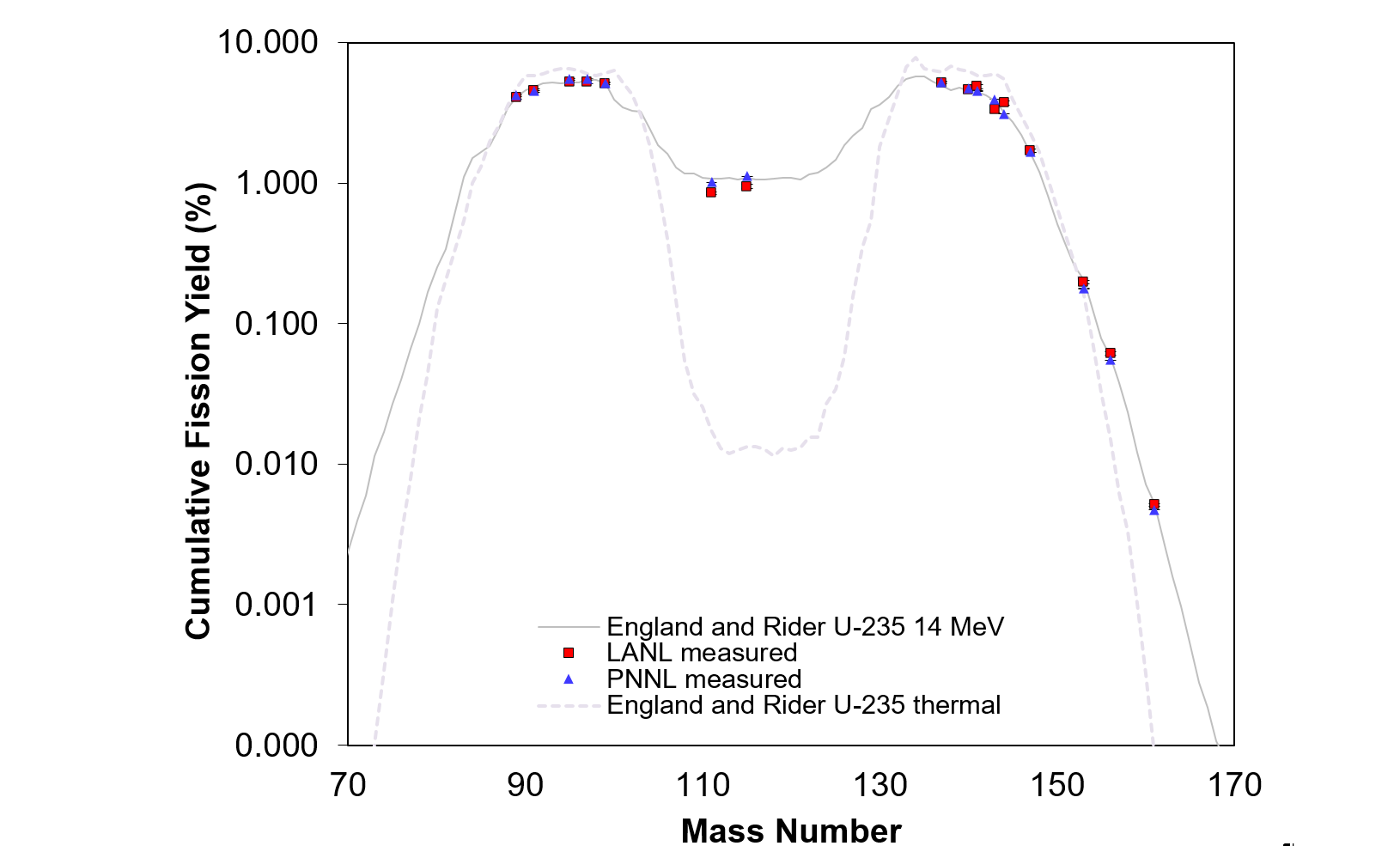
The graph shows fission product distributions measured for U-235 irradiated at the PNNL D-T generator (14 MeV spectrum). All yields are calculated relative to Mo-99.
Large targets of both materials, irradiated at PNNL, were analyzed for a suite of fission products and short-lived actinides using separated element radiochemistry. A team of scientists from the LANL Nuclear and Radiochemistry group completed measurements for 89Sr, 91Y, 95Zr, 97Zr, 99Mo, 111Ag, 115,115mCd, 136Cs, 137Cs, 140Ba, 141,143,144Ce, 147Nd, 153Sm, 156Eu, 161Tb, 237U and 239Np. Good agreement was observed, both between the two analytical laboratories and with the theoretical values for cumulative fission product chain yields in the high-energy spectrum.
“These experiments are significant because the high-energy neutron (14 MeV) spectrum induces a significantly different fission product distribution than the thermal spectrum typically evident in nuclear reactors,” said Susan Hanson, Radiochemistry Team Lead (C-NR).
This is reflected by elevated yields for valley and wing isotopes such as 111Ag, 115Cd, and 161Tb. For DU, the higher energy spectrum could also be probed by an increase in 237U versus 239Np production, with excellent actinide analysis agreement between laboratories.
Similar calibration experiments in the 14-MeV endpoint region were historically performed at LANL at the Cockcroft–Walton accelerator facility, but such experiments have not been conducted for decades. Future plans include expanding the suite of target fuels with plutonium and developing a tailored neutron energy capability at LANSCE.
Funding and mission
This work was funded by the NNSA Office of Defense Nuclear Nonproliferation Research and Development. The work supports the Laboratory’s Nuclear Deterrence mission area and the Science of Signatures and the Nuclear and Particle Futures capability pillars.
LANL research team: Mitzi Boswell, Don E. Dry, Mateusz Dembowski, Andrew J. Gaunt, Susan K. Hanson, Lisa A. Hudston, Mike R. James, William S. Kinman, Gabrielle Lee, Cheriece Margiotta, Iain May, Daniel Meininger, Jeffrey L. Miller, Sean Reilly, Randy J. Rendon, Jennifer R. Romero, Nathan C. Smythe, Jennifer M. White, Josh M. Williams, and Melinda S. Wren.
Technical contact: Susan Hanson
Earth and Environmental Sciences
QUIC-Fire is first laptop-capable wildfire management software
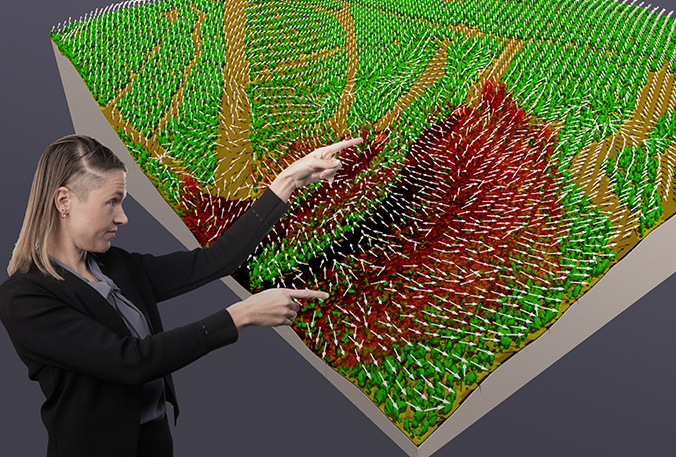
Sara Brambilla demonstrates QUIC-Fire.
Massive wildfires are occurring more frequently—an unintended consequence from decades of fire suppression and buildup of combustible fuels. Wildfire managers needed a tool to cope with the risks of these high-intensity wildfires as well as proactively moderate fire behavior.
To address this need, Los Alamos researchers in Earth and Environmental Sciences (EES) and Analytics, Intelligence, and Technology (A) divisions worked with partners at the United States Forest Service and Tall Timbers Research Station to invest QUIC-Fire.
Watch a video on QUIC-Fire here.
Feedback between fire and atmosphere
QUIC-Fire takes into account the feedback that occurs between a burning fire and the atmosphere. These aren’t fixed variables that can be easily modeled or parameterized. As a fire burns, the wind, temperature, and smoke all change. These variables then influence the fire spread, which influences the variables. QUIC-Fire acknowledges this feedback loop to produce more accurate and realistic simulations while avoiding the burden of computational fluid dynamics simulations.
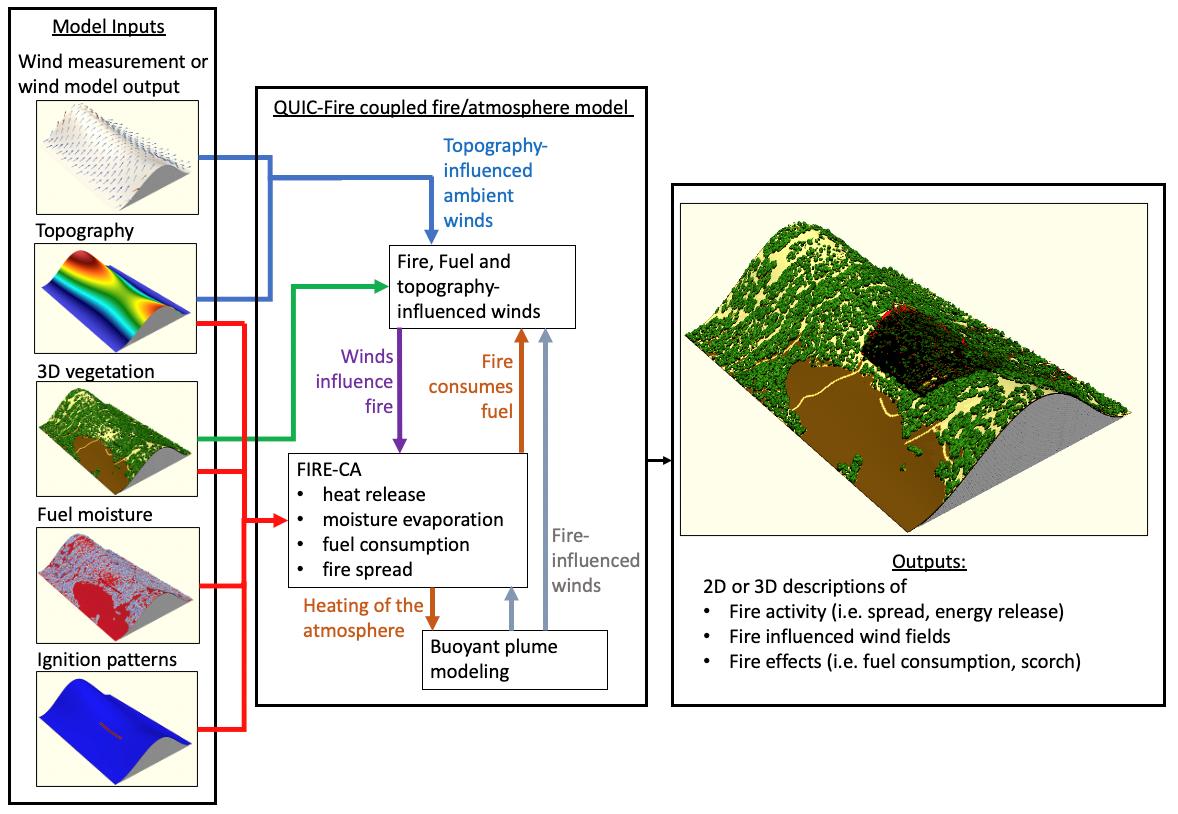
Exemplification of the QUIC-Fire workflow.
QUIC-Fire combines physics-based models of combustion, heat transfer, aerodynamic drag, and turbulence with a fast-running wind solver that represents the fire, fuel, and topography-influenced wind flow around the fire. Fire managers can use this powerful tool to simulate different ignition scenarios for prescribed burns. This is quite valuable for ensuring safety, smoke exposure, and fire behavior are all within specifications.
Future training and a changing climate
Firefighters will also benefit from QUIC-Fire by using it as a training tool. Like a flight simulator, a fire simulator built on QUIC-Fire will transform a training experience into a virtual reality session in which firefighters can explore the effects of both their ignition strategies and changes in burn conditions on fire and smoke outcomes.
This type of training is increasingly important as vegetation and weather change with the changing climate, creating circumstances that have never been encountered before. Firefighters and fire managers will need to know how to handle these new complex variables and their interactions in order to ensure safety of the public and surrounding infrastructure.
In fall 2020, QUIC-Fire was awarded an R&D 100 Award and a Gold Medal for Corporate Social Responsibility.
Funding and mission
The work was funded by the U.S. Forest Service and the LANL Laboratory Directed Research & Development Program (LDRD. The work supports the Laboratory’s Global Security mission area and the Integrating Information, Science, and Technology for Prediction capability pillar.
Reference: R. R. Linn, S. L. Goodrick, S. Brambilla, M. J. Brown, R. S. Middleton, J. J. O'Brien, and J. K. Hiers. “QUIC-fire: A fast-running simulation tool for prescribed fire planning.” Environmental Modeling and Software. Volume 125. 2020. https://doi.org/10.1016/j.envsoft.2019.104616
Technical contacts: Rod Linn and Sara Brambilla
Infrastructure Enhancement
BSL-2 Lab in Chemical Microscopy Facility expands
In fall 2020, the Biosafety Level 2 Laboratory (BSL-2) in LANL’s Chemical Microscopy Facility (TA-46, Building 158) was expanded, tripling in size to nearly 1,000 square feet. Operated by the Chemistry Division’s Physical Chemistry and Applied Spectroscopy group (C-PCS), the BSL-2 facility aids novel research for alpha-emitting and other radionuclides of interest in biological systems.
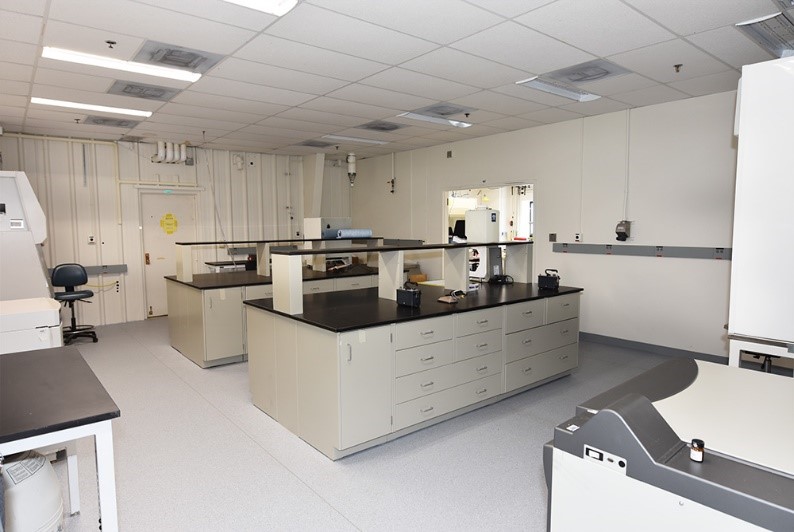
Nearly 1,000 square feet for radioanalytical research in Biosafety Level 2 (BSL-2) space was added to the Chemical Microscopy Facility. The older, 300-square-foot lab can be seen through the door in the rear.
Main infrastructure enhancements for the facility include the following:
- About 700 square feet of added space
- A hard-ducted Class ll/B2 BiochemguardTM biological safety cabinet (the first at LANL)
- A HEPA-filtered radioisotope chemical fume hood
- Advanced fiber-coupled spectroscopic capabilities
The facility is already an effective resource for evaluating efficacy of targeted alpha therapeutics, and the expansion further bolsters the research efforts. Much like targeted radionuclides used in cancer therapy, the Los Alamos researchers are exploiting the use of radionuclides for pathogen treatment.
“We are exploring a new class of alpha therapeutics for the treatment of antibiotic-resistant human pathogens,” said Laura Lilley, C-PCS. These include particularly tenacious pathogens, such as Pseudomonas aeruginosa, Staphylococcus aureus, and Yersinia pestis, the pathogen that causes plague.
The expansion provides the needed infrastructure to begin testing more types of radionuclides, beyond the thorium-227 and bismuth-213 radionuclides already being assessed. A Class ll/B2 Biochemguard™ biological safety cabinet was added to the facility. The new cabinet improves research safety for scientists exposing pathogens classified as Biosafety Level 2 to radioactive materials. Potentially, this cabinet will aid research with increased activity limits.
The expanded facility will include research with uranium and natural thorium to study the deleterious effects of radiological materials on living organisms, such as the human body.
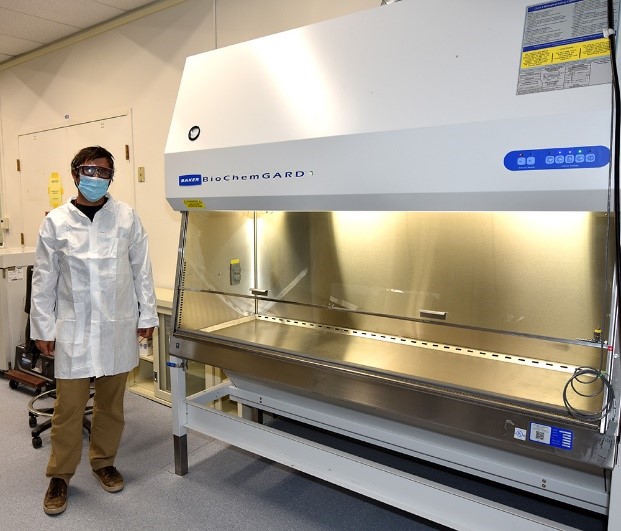
Researcher Ben Stein (C-PCS) stands in front of a hard-ducted biological safety cabinet designed for Risk Group-2 organisms and small quantities of radioactive materials. The specialized cabinet represents a unique capability at LANL.
In addition, a HEPA-filtered radioisotope chemical fume hood is currently being installed to allow experiments to include transuranic materials.
Capability development funds from the Associate Laboratory Directorate for Chemical, Life, and Earth Sciences enabled the purchase and installation of advanced fiber-coupled spectroscopic capabilities to enhance chemical characterization. These capabilities are in addition to the extensive spectroscopic and microscopic resources already present in the Chemical Microscopy Facility.
Funding and mission
Funding for this resource was provided by the LANL Laboratory Directed Research and Development (LDRD) program and the DOE BES Heavy Element Chemistry Program. The facility supports the Laboratory’s Global Security mission area and the Science of Signatures capability pillar. The researchers acknowledge Michael Fitzpatrick; the TA-48 RCTs Audrey Garcia, Laura Lilly, Veronika Mocko, Harshini Mukundan, Dina Siegel, Benjamin Stein, Gregory Wagner; and the TA-46 Facility Operations Director for making this possible.
Technical contact: Gregory Wagner
High-explosives R&D Crystal Lab relocation and renovation complete
This fall, the Crystal Lab facility was completed, consolidating high explosives R&D operations from four buildings across the Lab into a newly renovated 4,000 square foot building. The new consolidated Crystal Lab increases the space dedicated to HE crystal R&D by three times. And despite COVID restrictions, the work was completed without one safety incident and on schedule.
Los Alamos is the only place in the country where HE single crystals can be grown and where samples of these crystals can be prepared for mesoscale energetic materials research.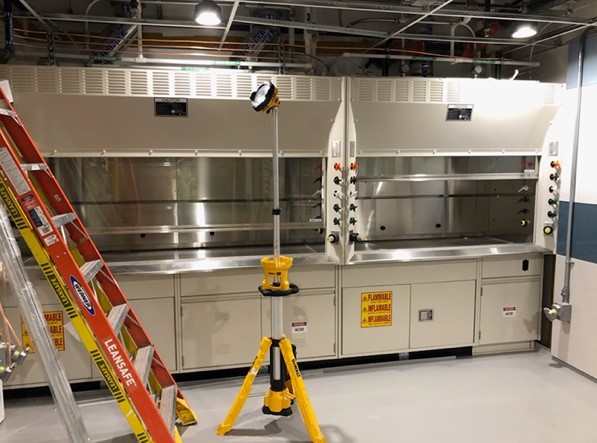
A fume hood in the newly renovated Crystal Lab facility at TA-16.
“This research focuses on characterization of the structure and properties of HE crystals and application of this knowledge to improve the design and manufacture of energetic materials for current and future weapons systems,” said project manager Mike Fichtel (ALDW). This type of research is done throughout LANL, other Department of Energy and Department of Defense facilities, and university labs, as well as for international collaborations including the US–UK Mutual Defense Agreement.
Before the Crystal Lab was completed, this research at LANL had been conducted primarily at TA-40 in a building that was much too small to support the current operations, with ancillary operations in three other aging buildings spread across two additional technical areas. So when it was determined that an old, underutilized building at TA-16 could accommodate this research under one roof, the High Explosives Science and Technology group (Q-5) set out in spring 2018 to renovate the 4,000-square-foot concrete structure—called the Crystal Lab project.
“This facility provides nearly three times as much space as the existing facility with a state-of-the-art HVAC system to provide heating and cooling to within 1 degree Fahrenheit, ensuring extremely tight tolerances can be achieved in programmatic operations,” Fichtel said. “The consolidated operations in one purpose-built facility will greatly accelerate work flows of HE science and technology development.”
The project, one of the high-level deliverables for the NNSA’s Safety, Infrastructure, and Operations (NA-50) “Make it Happen” list, was conducted without a single safety incident and stayed on-track despite the coronavirus pandemic. The robust safety plan implemented by contractor HB Construction, coupled with a strong project team, were paramount to this project’s success. This is one of the first modern HE laboratories at Los Alamos in many decades, serving as a template for much larger facilities planned for the near future.
Funding and mission
The Crystal Lab was funded by the Weapons Infrastructure Program Office. The facility supports the Laboratory’s Nuclear Deterrence mission area and the Weapons Systems and the Science of Signatures capability pillars.
Technical contact: Mike FichtelMaterials Physics and Applications
First connection between a specific phase transition and superconductivity
A collaboration between Los Alamos materials scientists and researchers at Cornell University and the National High Magnetic Field Laboratory in Tallahassee resulted in the first experimental connection between a specific phase transition—evinced by a reconstruction of the material’s Fermi surface—and superconductivity in the cuprates.
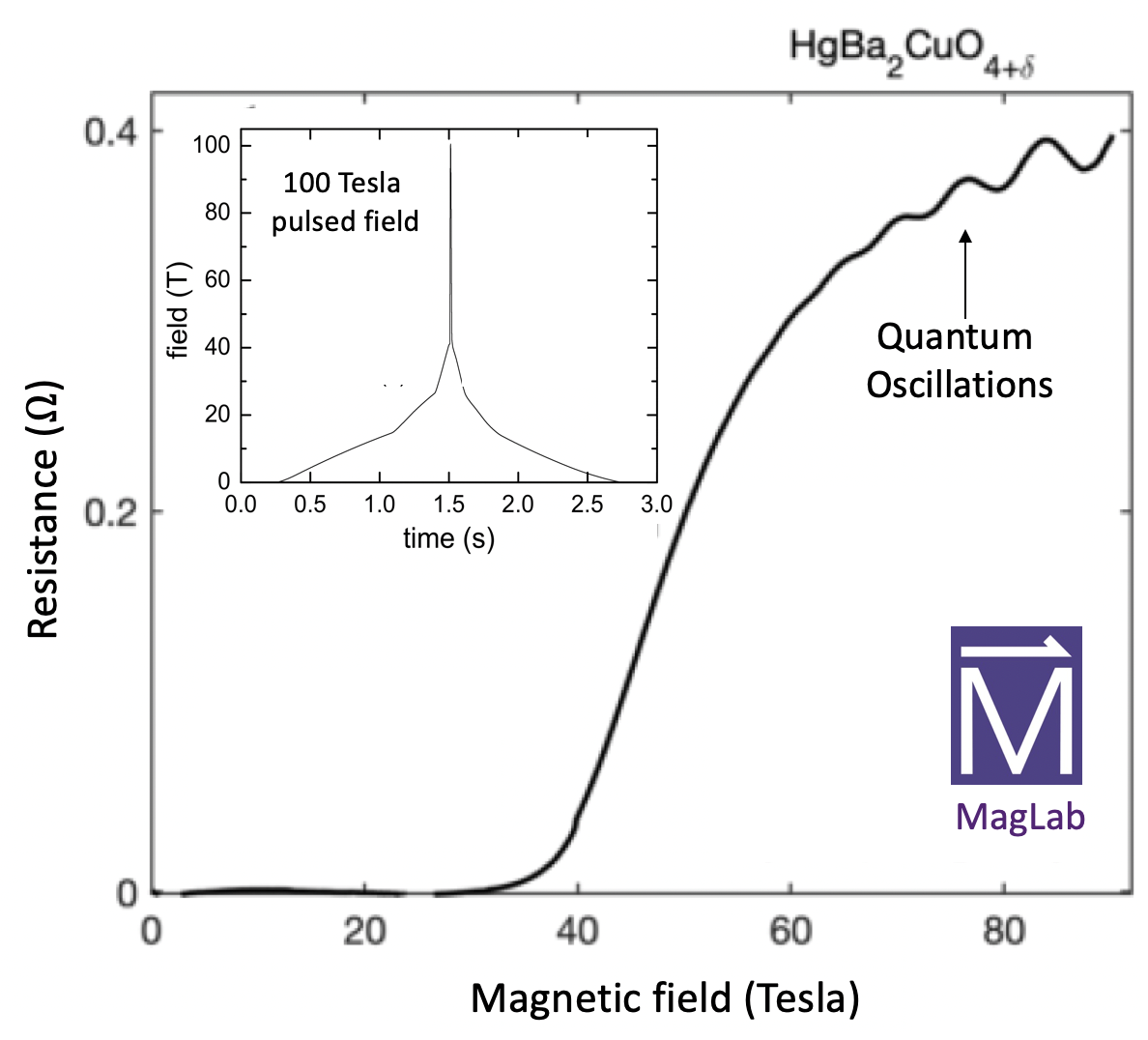
Graphed is the change of resistance with applied magnetic field in the high-temperature superconductor. Superconductivity is suppressed by magnetic fields larger than ~35 T, revealing quantum oscillations of the resistance that is a direct probe of the Fermi-surface reconstruction by charge-density-wave state. Inset: Pulse field profile of the 100-T multi-shot magnet at LANL used in this study.
An under-doped cuprate material was used to aid understanding of emergent phenomena in strongly interacting electronic systems. Cuprates are a class of materials containing copper-oxide planes that superconduct at unprecedentedly high temperatures (up to ~135 K at ambient pressure). However, the canonical theoretical framework of material physics has failed to account for the high-temperature superconductivity. A novel theoretical paradigm stipulates that it results from quantum critical fluctuations associated with a zero-temperature phase transition. Such a quantum critical point is typically “hidden” by the strong superconductivity, effectively obscuring its properties.
Therefore, the researchers used extremely high magnetic fields (up to 90 tesla) at the National High Magnetic Field Laboratory (NHMFL)-Pulsed Field Facility to suppress superconductivity. This allowed the electronic ground state of a model cuprate, HgBa2CuO4+d, to be revealed. The researchers found signatures of a charge-density-wave, a state comprising spatial modulations of the electronic charge density, which reconstructs the Fermi surface. The researchers traced the charge-density-wave to putative quantum critical points, thus establishing, for the first time, a connection between a specific phase transition and superconductivity.
Superconducting materials are already widely deployed in a range of fields, such as electrical power distribution, MRIs for healthcare, and even large-scale scientific facilities such as the Large Hadron Collider. The extreme magnetic fields available at LANL are instrumental to providing insight into the fundamental mechanism for high-temperature superconductivity. This research will ultimately provide a guide for future discovery of superconductors with desirable properties, e.g., superconductivity at ambient conditions and topological superconducting order suitable for quantum computing.
Funding and mission
The work was funded by the Department of Energy Basic Energy Sciences “Science of 100 T” grant. The NHMFL-Pulsed Field Facility and related technical support are funded by NSF Cooperative Agreement, the State of Florida, and the U.S. Department of Energy. Crystal growth was supported by the LANL Laboratory Directed Research and Development program. The research supports the Laboratory’s Energy Security mission area and the Materials for the Future capability pillar, focusing on emergent phenomena in materials.
Researchers: Mun K. Chan, Ross D. McDonald, B. J. Ramshaw, Jon B. Betts, Neil Harrison (National High Magnetic Field Laboratory-Pulsed Field Facility, MPA-MAGLAB); Eric D. Bauer (Quantum, MPA-Q); and Arkady Shekhter (National High Magnetic Field Laboratory, Florida).
Reference: “Extent of Fermi-surface reconstruction in the high-temperature superconductor HgBa2CuO4+d.” Proceedings of the National Academy of Sciences. 117 (18) 9782–9786 (2020). https://doi.org/10.1073/pnas.1914166117
Technical contact: Mun ChanMaterials Science and Technology
Modeling predicts the role of grain boundary structure in materials in extreme environments
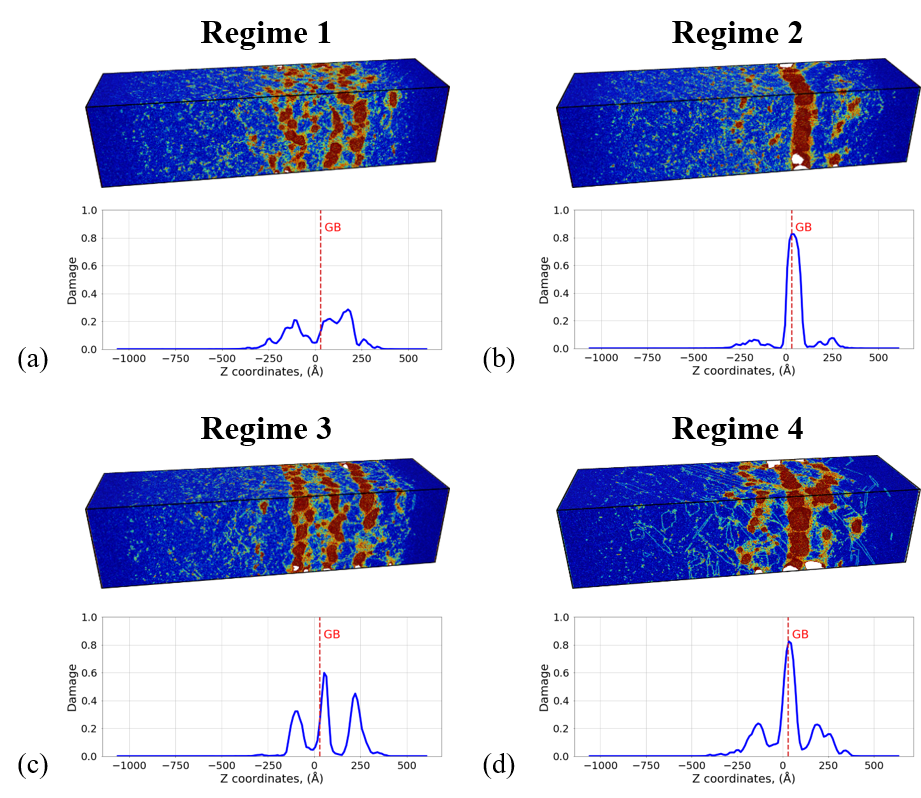
Snapshots of four representative grain boundaries (GB) at 50 ps. Regime 1, random distribution of damage throughout the spall region. Regime 2, sharp spall plane at the GB, with small voids in the non-GB spall region. Regime 3, three separation planes, one at the GB, and two on each side of the GB at a distance of ~10 nm. Regime 4, sharp separation plane at the GB, with medium-size voids in the non-GB spall region. The four distinct failure modes can be clearly observed from the plots of damage distribution as a function of Z position.
Researchers from Materials Science in Radiation and Dynamics Extremes (MST-8) filled a knowledge gap towards predicting the total damage in metals in extreme environments as a function of grain boundary characteristics. Their findings also provide a simple physics-based criterion showing the variation in the morphology of the spall planes, which is usually not well predicted by mesoscale simulations but is observed in experiments.
Their work aids in understanding the role of grain boundaries on the dynamic response of materials, which is a crucial first step toward engineering nanocrystalline and polycrystalline materials suitable for use in extreme environments. Gaining this insight through experiment alone is not possible because of the fine spatial and temporal resolution required. Hence, atomistic modeling is useful.
In their work, the researchers performed systematic molecular dynamics simulations on 185 grain boundaries in tantalum. To reflect the diversity in the local atomic structure observed in realistic grain boundaries, their samples encompassed both ordered and disordered structures. The results reveal four distinct regimes in damage distribution and failure modes as a function of mis-orientation angle. Variation in the local atomic structure was shown not to affect the failure mode. These trends correlate with the variation in the corresponding void nucleation stress.
The results can be used to develop a damage criterion for grain boundaries in various regimes that can then be used in mesoscale simulations of polycrystalline metals.
Funding and mission
The work, which leveraged the Laboratory’s expertise in materials modeling and its Institutional Computing Program, was supported by the DOE/NNSA ASC Physics and Engineering Models subprogram (LANL Program Manager Cathy Plesko, acting) from within the Materials project (LANL Project Leader D.J. Luscher). The research supports the Laboratory’s Nuclear Deterrence mission area and the Materials for the Future capability pillar, in particular the Defects and Interfaces science theme.
Reference: J. Chen and S.J. Fensin. “Associating damage nucleation and distribution with grain boundary characteristics in Ta.” Scripta Materialia 187 (2020). https://doi.org/10.1016/j.scriptamat.2020.06.035
Technical contact: Saryu FensinIntegrated approach accelerates nuclear fuel development and qualification
A novel strategy exploiting advanced modeling and simulation techniques and leveraging existing capabilities promises to transform nuclear fuel development and qualification.
In research appearing in the Journal of Nuclear Materials, Christopher Stanek of Materials Science in Radiation and Dynamics Extremes (MST-8) and external collaborators outline a process integrating advanced modeling and simulation tools with separate-effects testing. This “co-design” technique, which combines experiment with modeling, enables integral fuel performance analyses with reduced time for developing and qualifying a new fuel system as well as reduced associated costs.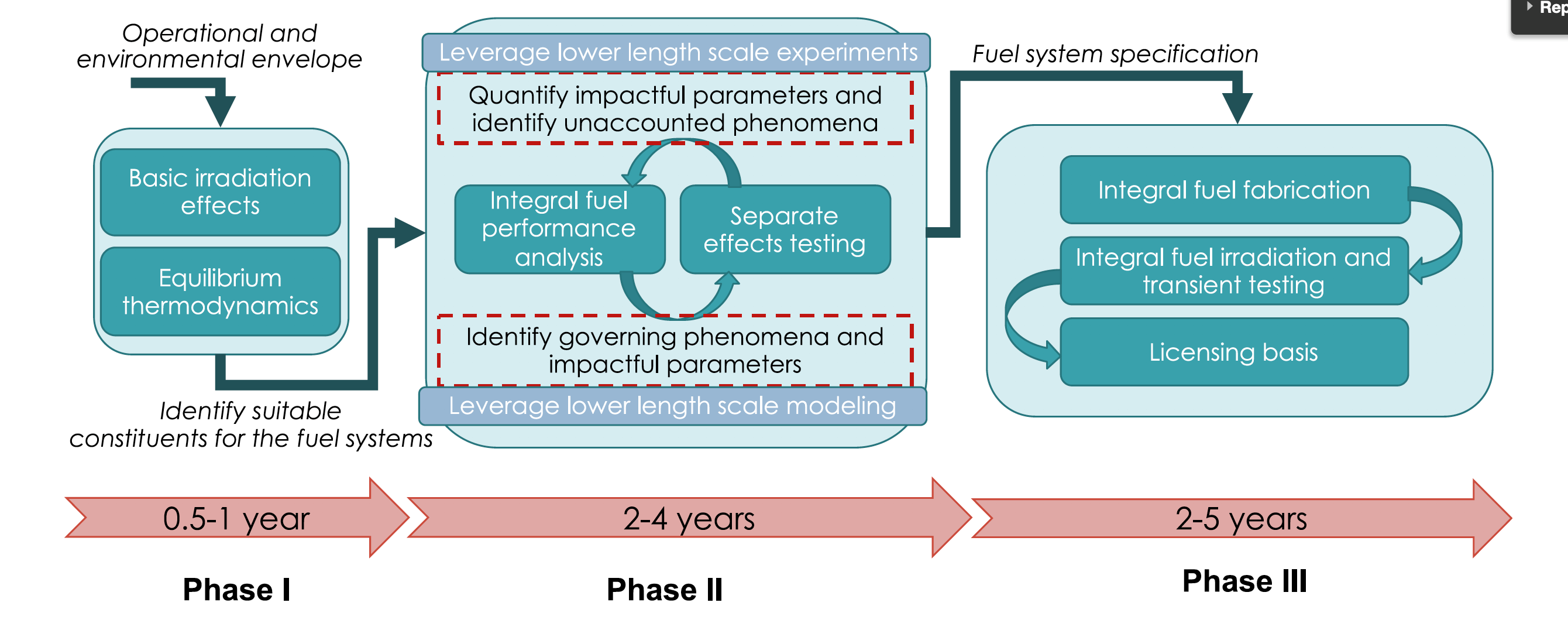
The process workflow for accelerated fuel qualification consists of three distinct phases. The information generated and the decisions made at the end of each phase guide and orient the subsequent work to efficiently reach a successful outcome. Advanced modeling and simulation methods made available only within the past decade are at the core of this approach to facilitate constituent and system selection in Phase I, produce functional integral fuel performance designs in Phase II, and provide the licensing basis in Phase III.
The approach is a departure from the experimental trial-and-error method intrinsic to the historic paradigm, which was successful but typically required more than 20 years to progress from a new integral fuel concept to one qualified and approved for deployment by a regulator.
The coupling of experiment with advanced modeling and simulation, including sensitivity analyses and uncertainty quantification, can accelerate the development of new fuel concepts, expand their operational envelope, and reduce the dependence on exhaustive integral testing. The new approach will update the inefficiencies of the previous methodology, opening the door for more innovative fuels.
“The next steps converting the vision described in this paper into reality are critical,” Stanek said. According to the researchers, this process, which enables innovation in the nuclear industry, is the best way to modernize and accelerate cost-effective research, development, and deployment of high-performance, safer nuclear fuel technologies.
Increasing the urgency in adopting this method is the dwindling number of experimental nuclear facilities that allow for separate-effects or integral irradiation testing of nuclear fuels. This also highlights the need to recapitalize these facilities to support the high volume of small-scale tests necessary to inform integral fuel performance modeling.
“LANL has a key role to play in both the computational and experimental elements of this important initiative,” Stanek said.
Funding and mission
The research was funded by the DOE Office of Nuclear Energy, jointly under the Advanced Fuels Campaign and Nuclear Energy Advanced Modeling and Simulation programs. The work supports the Laboratory’s Energy Security mission area and the Materials for the Future capability pillar.
Researchers: Christopher Stanek (MST-8); Kurt A. Terrani, Nathan A. Capps, Andrew T. Nelson (Oak Ridge National Laboratory); Matthew J. Kerr, Steven L. Hayes (Idaho National Laboratory); Christina A. Back (General Atomics); Brian D. Wirth (University of Tennessee).
Reference: “Accelerating nuclear fuel development and qualification: Modeling and simulation integrated with separate-effects testing,” Journal of Nuclear Materials 539 (2020). https://doi.org/10.1016/j.jnucmat.2020.152267
Technical contact: Christopher StanekTheoretical
Detailed mapping of HIV ‘sugar shield’ could aid vaccine design
Researchers in LANL’s Theoretical (T) Division along with their partners from Scripps Research Institute developed a novel imaging method that led to the most detailed glycan (or sugar molecule) mapping of HIV. These sugar molecules shield the virus from the immune system, and therefore, gaps where sugar is lacking are ideal for vaccine targeting.
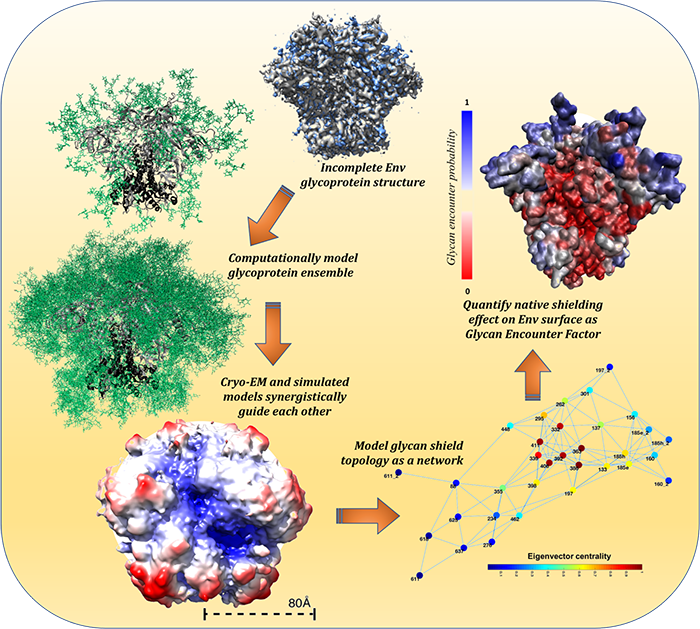
Cryo-electron microscopy experiments and extensive computational modeling synergistically guide the mapping of the HIV viral glycan shield in unprecedented detail.
Sugar shields, which are extremely dynamic and flexible, have been notoriously difficult to image; however, they are incredibly important for HIV, influenza, and coronavirus treatment. The density of this protective barrier can vary over the viral spike proteins, essentially determining where antibodies can and cannot bind.
The researchers used an integrated approach to imaging that included cryo-electron microscopy, computational modeling, and site-specific mass spectrometry. This novel method delivered the first-ever detailed mapping of sugars on the HIV spike protein, known as Env.
Along with sugar location, the researchers gained an understanding about the dynamic nature of the molecules. They found that the individual sugars don’t just move around randomly on the spike protein’s surface, rather the sugars clump together in tufts and thickets, interacting with each other.
Likewise, when the researchers began removing the sugars from Env, they found the functionality, shape, and stability of Env began to fall apart. This elucidated a new role of which the researchers were unaware the sugars were playing.
“Being able to visualize and quantify the glycan shield in such extraordinary detail gives us an edge in the ongoing battle against viruses,” said lead author Srirupa Chakraborty, a postdoctoral researcher in Theoretical Biology and Biophysics (T-6) and the Center for Nonlinear Studies (CNLS).
This new sugar-shield mapping approach is poised to aid vaccine design and development for many glycogen-shielded viruses, including HIV.
Funding and mission
The researchers acknowledge the LANL High Performance Computing Division for providing computational facilities. This work was supported by the National Institutes of Health (NIH) National Institute of Allergy and Infectious Diseases (CHAVD), the Bill and Melinda Gates Foundation, and the IAVI Neutralizing Antibody Center. The research supports the Laboratory’s Global Security mission area and the Integrating Information, Science, and Technology for Prediction capability pillar.
References: Z. T. Berndsen et al. “Visualization of the HIV-1 Env glycan shield across scales,” Proceedings of the National Academy of Sciences (2020). DOI: 10.1073/pnas.2000260117
Chakraborty et al. “Quantification of the Resilience and Vulnerability of HIV-1 Native Glycan Shield at Atomistic Detail,” Cell iScience. In Press. https://doi.org/10.1101/846071Related article: New imaging method reveals HIV's sugary shield in unprecedented detail
Technical contact: Gnana Gnanakaran
New boundaries established for sea-ice models
A Los Alamos researcher from the Fluid Dynamics and Solid Mechanics group (T-3) supporting the Energy Exascale Earth System Model (E3SM) project collaborated with international colleagues to identify the benefits, limitations, and boundaries of sea-ice modeling tools.
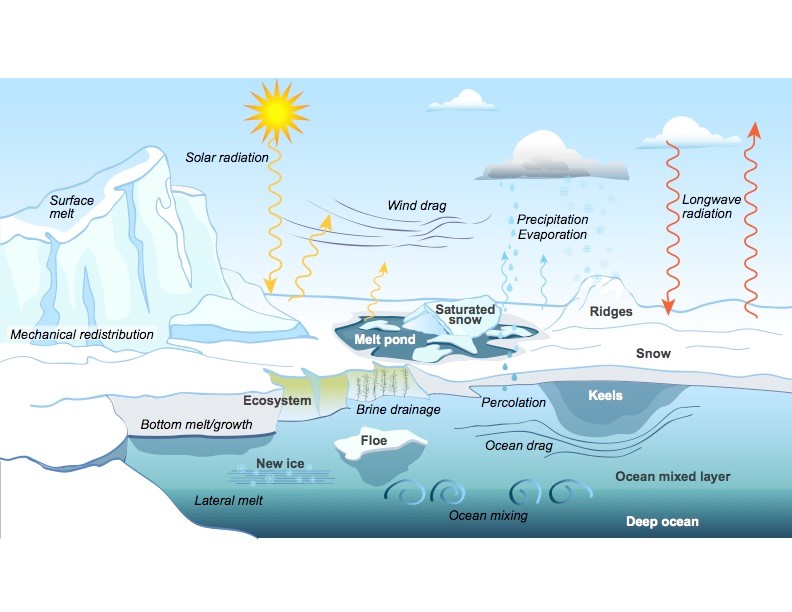
A CICE Consortium graphic of sea-ice physics illustrates the complexity and volume of variables at play.
The research sheds light on the challenges, but also some of the opportunities, of employing complex sea-ice models for short-term forecasting. Many of these powerful models, including the CICE sea-ice model, were developed specifically for research purposes and were later adopted by short-term forecasters.
“The desire to understand and predict sea ice raises the question of whether more complex models—which incorporate a larger number and greater fusion of environmental processes and physics—can address the many concerns,” said Elizabeth Hunke, CICE Consortium leader.
Hunke and collaborators found that the answer is multifaceted, varying as the scientific and software requirements, computational expense, and necessary human support compete in a given situation.
What question does the model answer?
Sea ice is a complex material, and it is changing faster than ever before. Correspondingly, more people—including stakeholders, researchers, policy makers, and forecasters—are asking more questions concerning these unprecedented changes.
A model’s efficacy depends on how it is applied: there are no “good” or “bad” models, only good or bad choices in how they are used. A model should be selected based on the question being asked, and factors such as resource limitations must be considered.
Although complex models are generally good at averaging over values to provide answers such as where shipping lanes are likely to open as ice melts (a question that impacts national security and policy makers), these models are less ideal for specifying real-time details such as where convergence is causing the ice to form thick, impenetrable ridges (a question of concern for ship captains).
As such, the current concept of a one-size-fits-all model is not straightforward. Instead, the researchers suggest a future framework that is flexible enough to allow users to toggle variables and processes on or off based on their applications, and enables knowledge and code sharing among research and forecasting centers.
Funding and mission
This work was performed under the Energy Exascale Earth System Model project of the U.S. Department of Energy’s Biological and Environmental Research Division. The research supports the Laboratory’s Global Security mission area and the Integrating Information, Science, and Technology for Prediction capability pillar.
References:
- Hunke et al. “Should Sea-Ice Modeling Tools Designed for Climate Research be used for Short-Term Forecasting?” Current Climate Change Reports. 2020. https://doi.org/10.1007/s40641-020-00162-y
- Hunke. “The Challenges and Opportunities of One-size-fits-all Sea-ice Models.” SIAM News. October 2020.
- Blockley et al. “The future of sea ice modelling: where do we go from here?” Bulletin of the American Meteorological Society, 2020. DOI 10.1175/BAMS-D-20-0073.1
Technical contact: Elizabeth Hunke


